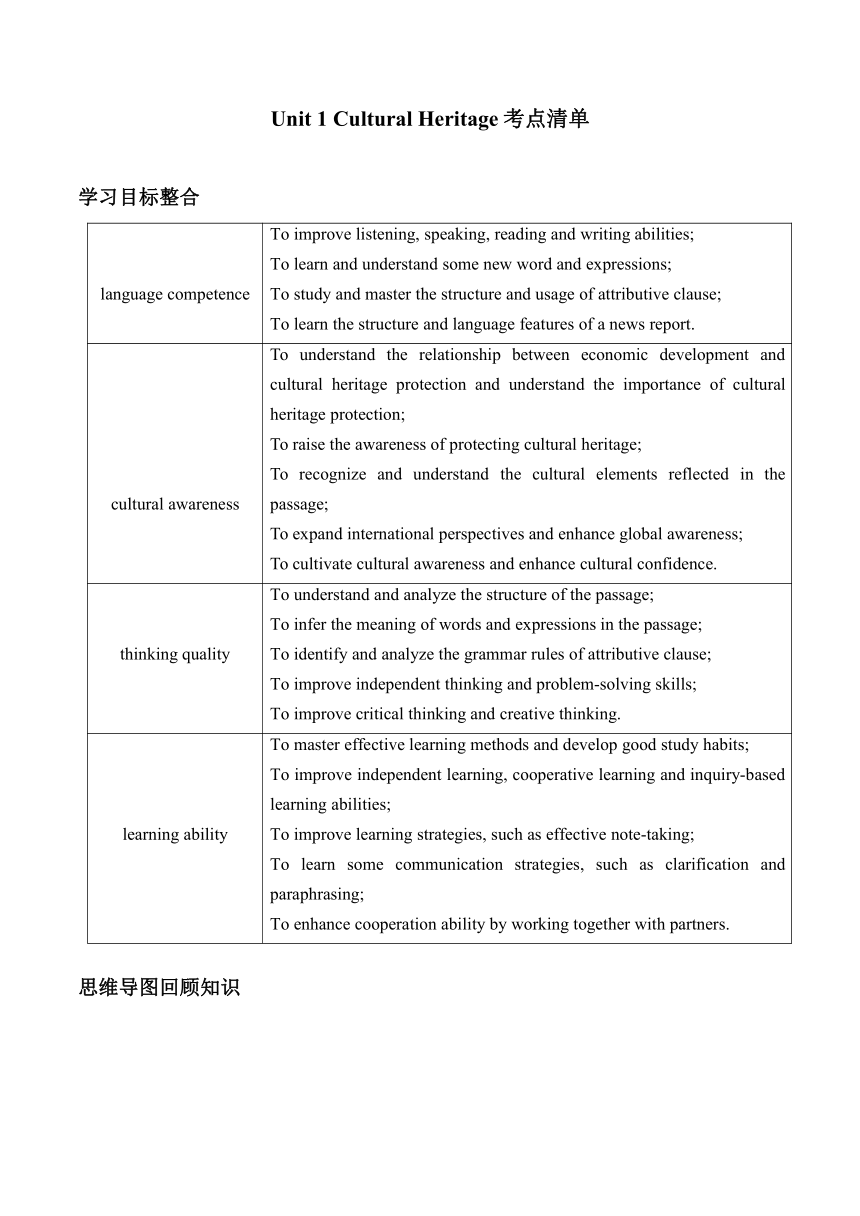
Unit 1 Cultural Heritage考点清单 学习目标整合 language competence To improve listening, speaking, reading and writing abilities; To learn and understand some new word and expressions; To study and master the structure and usage of attributive clause; To learn the structure and language features of a news report. cultural awareness To understand the relationship between economic development and cultural heritage protection and understand the importance of cultural heritage protection; To raise the awareness of protecting cultural heritage; To recognize and understand the cultural elements reflected in the passage; To expand international perspectives and enhance global awareness; To cultivate cultural awareness and enhance cultural confidence. thinking quality To understand and analyze the structure of the passage; To infer the meaning of words and expressions in the passage; To identify and analyze the grammar rules of attributive clause; To improve independent thinking and problem-solving skills; To improve critical thinking and creative thinking. learning ability To master effective learning methods and develop good study habits; To improve independent learning, cooperative learning and inquiry-based learning abilities; To improve learning strategies, such as effective note-taking; To learn some communication strategies, such as clarification and paraphrasing; To enhance cooperation ability by working together with partners. 思维导图回顾知识 重难知识易混易错 定语从句 一、关系词 关系代词和关系副词 指代对象 例句 that作主语或宾语 指物 1) It is Mount Tai that lies in Shandong Province.(作主语) 2) That is the most interesting story (that) I have ever heard of.(作宾语) 指人 1) Who is the man that is reading a book over there (作主语) 2) The girl (that) we saw yesterday is his sister.(作宾语) which作主语或宾语 指物 1) My favorite place is Kunming which is known as the Spring City.(作主语) 2) This is the place (which) he would like to visit.(作宾语) who, whom,和whose分别作主语,宾语和定语 (先行词在主句和从句中都作宾语时用whom) 指人 1) The tall man who is playing basketball is Yao Ming.(作主语) 2) That is the girl (whom) I met at the party yesterday.(作宾语) 3) Is this the boy whose parents went to Canada last year.(作定语) when, where和,why分别作时间状语,地点状语和原因状语 1) I shall never forget the day when we first met in a park.(作时间状语) 2) My favorite city is Beijing where I can visit the Great Wall.(作地点状语) 3) This is the reason why you should leave.(作原因状语) 注意: that和which都可指物,且在句中都可作主语和宾语,多数情况下可以互换。但在以下情况中,关系代词只能用that,不能用which。 1. 先行词既指人又指物。 2. 先行词被all, every, any, little, only, much, no等不定代词修饰时,或先行词本身是all, much, everything, anything, no以及no构成的复合词。 3. 先行词被形容词最高级或序数词修饰。 4. 先行词被the only, the very, the last, the same修饰。 5. 有两个或两个以上分别表示人和物的先行词。 6. 主句以who, what, w ... ...
~~ 您好,已阅读到文档的结尾了 ~~

